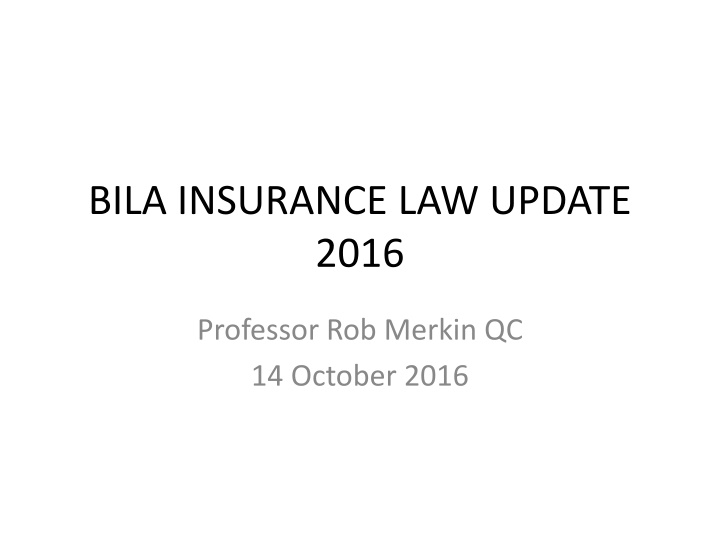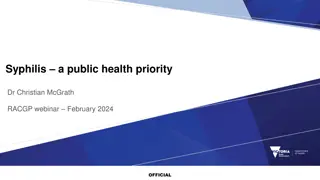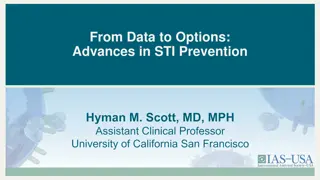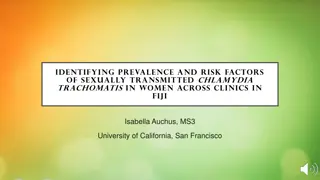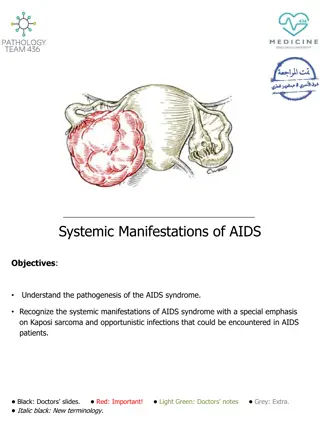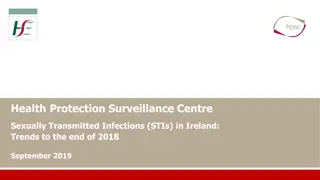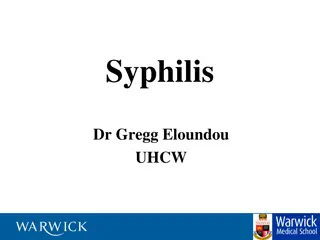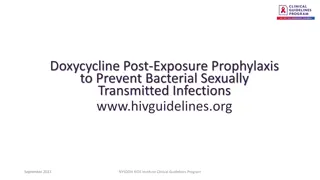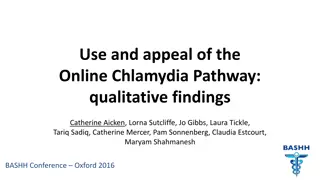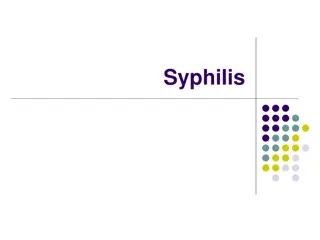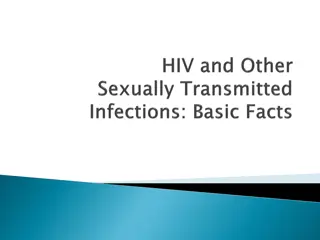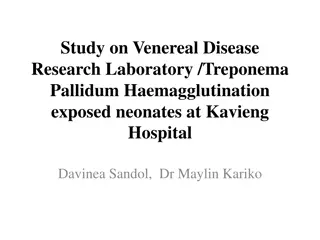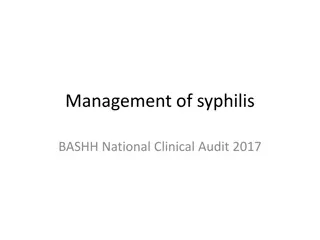STI Pathogens: Syphilis, Gonorrhea, and Chlamydia
Delve into the causative agents, pathogenesis, clinical features, diagnostic methods, and treatment of syphilis, gonorrhea, and Chlamydia infections. Explore different laboratory tests, Chlamydia morphology, genera, species, and urogenital syndromes caused. Understand the epidemiology and pathogenesis of Chlamydia.
Download Presentation

Please find below an Image/Link to download the presentation.
The content on the website is provided AS IS for your information and personal use only. It may not be sold, licensed, or shared on other websites without obtaining consent from the author.If you encounter any issues during the download, it is possible that the publisher has removed the file from their server.
You are allowed to download the files provided on this website for personal or commercial use, subject to the condition that they are used lawfully. All files are the property of their respective owners.
The content on the website is provided AS IS for your information and personal use only. It may not be sold, licensed, or shared on other websites without obtaining consent from the author.
E N D
Presentation Transcript
BILA INSURANCE LAW UPDATE 2016 Professor Rob Merkin QC 14 October 2016
THE CLAIMING FRAUDSTER Versloot v HDI [2016] UKSC 45 (1) If a claim was fraudulent the assured lost the entirety of the claim, and it was not severable even if each part was independent. (2) Once the contract was made, the duty of good faith was subject to contract law, and the fraudulent claims rule was to be regarded as an implied term or public policy notion. (3) The purpose of the fraudulent claims clause was the deterrence of fraud. (4) The rule against fraudulent claims did not apply to collateral lies: the right to indemnity arose as soon as the loss was suffered, so that if the claim was lost following a lie there was disproportionate forfeiture; there was a difference between dishonesty which was and was not designed to get more than legal entitlement; wasted effort was not the mischief aimed at by the fraudulent claims rule; and the civil law did not avoid a transaction on account of fraud that had no impact on its intended target.
THE SETTLING FRAUDSTER Hayward v Zurich [2016] UKSC 48: in order to set aside a compromise based on fraudulent misrepresentation: (a) the insurer did not need to prove that it was induced to enter into settlement because it believed that the representations were true; (b) it sufficed to establish influence that the fact of the misrepresentations was a material cause of the insurer entering into the settlement; and (c) it was difficult to envisage any circumstances in which mere suspicion that a claim was fraudulent would preclude unravelling a settlement when fraud was subsequently established.
THE CRIMINAL Patel v Mirza [2016] UKSC 42: the rule in Tinsley v Milligan that an assured who has to rely upon his illegality to make a claim is gone (if it ever existed in respect of illegal performance), replaced with a triple test: (a) what is the purpose of imposing criminality; is public policy furthered by a bar; (c) is a bar proportional?
THE IDIOT Barrie Toepfer Earthmoving v CGU [2016] NSWCA 67: BTE s policy excluded Recklessness or reckless failure to comply with any statutory obligations and stated that BTE had to exercise reasonable care to prevent loss, and comply with all statutory obligations . The assured carried an excavator on the back of a lorry, and damaged a low bridge. Held: (1) the burden of proving compliance was on the insurers; (2) the reasonable care clause required proof of recklessness, and the driver had not been reckless; (3) there was no absolute obligation to comply with legislative requirements. Matton Developments Pty Ltd v CGU Insurance Ltd [2016] QCA 208: a mobile crane collapsed while carrying a 39 tonne panel on a seven degree slope, in clear contravention of the manufacturer s manual and Australian Standards. Policy coverage if the overloading was accidental...non-deliberate and clearly unintentional and the resulting damage was accidental sudden and unforeseen. The operator appreciated the risk but thought that he weight of the crane and panel would compress the slope, so there was an accident and he had not courted the risk .
SUBROGATION Frasca-Judd v Golovina [2016] EWHC 497 (QB): Lease requiring L to insure, T not required to contribute to premium but required not to do any act vitiating insurance. Lease allocated risk of T s negligence to L, so no subrogation claim. Cape v Cape No 1 [2016] EWHC 1119 (QB): D became co-assured by endorsement and was immune from subrogation proceedings.
LIABILITY INSURANCE I Ocean Finance & Mortgages Ltd v Oval Insurance Broking Ltd [2016] EWHC 160 (Comm): OFML was required to undertake a review of its PPI sales, but neither the producing nor placing brokers advised OFML to make a block notification under its professional indemnity claims made policy. (1) Block notification should have been made. (2) Settlement with producing broker was reasonable. (3) Placing broker liable for 30% contribution. AIG Europe Ltd v OC320301 LLP [2016] EWCA Civ 367: Meaning of phrase series of related matters or transactions in professional indemnity policy. CA, reversing trial judge, held: the test for related was not interdependence but rather an intrinsic - as opposed to an external - connection. UK Insurance v Farrow [2016] EWHC 190 (QB): predominant purpose for keeping Jake the rotweiller was guard dog and not pet, so exclusion for liability applied. If wrong, there were concurrent causes and the exclusion for private use prevailed
LIABILITY INSURANCE II ARC Capital Partners Ltd v Brit Syndicates Ltd [2016] EWHC 141 (Comm): ARC had a professional indemnity claims made policy for October 2013 to October 2014 contained a retroactive date clause excluding claims arising from or in any way involving any act or omission prior to 5 June 2009 It also contained a continuity of cover clause extending to claims or circumstances that could have been notified in any earlier policy year. In January 2014 ARC sought to notify a claim made in April 2013. Held: (1) the retroactive clause did not apply, in that acts committed in 2008 were merely the background and history to the claim made in 2014 a causal link was required and the line had to be drawn somewhere.; (2) no claim had been made against ARC in April 2013, as there had not been a demand for payment; (3) if it had been necessary to rely on the continuity of cover clause, the clause was not subject to time limits contained in either policy or it would have been meaningless. Legg v Sterte Garage Ltd [2016] EWCA Civ 97: award of costs against liability insurer defending insolvent assured
ASBESTOS Cape v Cape (No 2) [2016] EWHC 1786 (QB): Claims straddling period before and after D had become co-assured. Insurer not entitled to recoup from D: D was not intentionally uninsured (believed it was insured); and insurer had received premiums for period before D was co-assured. IEG v Zurich distinguished.
PROPERTY INSURANCE Prattley v Vero [2016] NZHC 67: two earthquakes causing partial damage, and a third causing serious damage: (1) building not destroyed until rebuilding became impossible, third earthquake; (2) no recovery for unrepaired partial damage prior to destruction, by reason of indemnity; (3) if it had been necessary to allocate costs between the three earthquakes, modelling not helpful.
REINSURANCE MetLife Insurance v RGA Reinsurance [2016] NSWSC 980: MetLife provided TPD cover to employees of the Sydney police force at work and performing normal duties on the commencement date of the Policy, I July 2005. The reinsurance treaty with RGA covered a claim where the initial event leading to or contributing to that claim must occur after 1 July 2005. The question was whether the treaty applied to a police officer exposed to a traumatic event before 1 July 2005 but suffering psychological injury after 1 July 2005. The court held that the insurance and reinsurance had different triggers on 1 July 2005, that the back to back presumption between insurance and reinsurance had been ousted by the express wording of the clause.
MOTOR INSURANCE Moreno v MIB [2016] UKSC 52: in 2011, M, a UK resident on holiday in Greece, was seriously injured by an uninsured vehicle driven by B, who admitted liability. The SC ruled that the MIB was liable to pay damages to M in accordance with Greek and not English law, under regulation 13 of the Motor Vehicles (Compulsory Insurance) (Information Centre and Compensation Body) Regulations 2003. Obiter, the same applied under regulation 13, dealing with insured vehicles. UK Insurance v Holden [2016] EWHC 264 (QB): the obligation to insure for injury or damaged caused by or arising out of the use of a motor vehicle on a road or public place did not extend to a case where it was being repaired on private premises and the resulting fire spread to neighbouring properties. There was no use of the vehicle. There was no need to consider the effects of Vnuk v Triglav [2015] Lloyd s Rep IR 142, but the restriction to roads and public places was probably incompatible with EU law.
MARINE INSURANCE Connect Shipping v Sveriges [2016] EWHC 1580 (Comm): the was entitled to claim for a CTL: (1) notice of abandonment given with reasonable diligence after the receipt of reliable information about the loss; (2) under ITC there was CTL if repair costs exceeded insured value, and costs included costs incurred before notice of abandonment accepted. Atlas-Navegacao v Navigators [2016] EWCA Civ 808: war risks policy excluding The policy covered malicious acts but excluded arrest by reason of infringement of any customs or trading regulations . Strapping drugs to hull was malicious act, but concurrent exclusion prevailed
CONFLICT OF LAWS Axa v Weir [2016] EWHC (Comm) 904: WS, an Australian company was insurEd by AXA under an English global liability policy and a NSW broadform. The global policy applied where there was no local coverage. Neither policy contained a jurisdiction clause. AXA brought proceedings in England for negative declaratory relif, and WS commenced proceedings in NSW seeking indemnity under both policies. AXA s claim for an anti-suit injunction was refused. Since AXA was liable under the global policy only to the extent that there was no coverage under the broadform policy, determination of the position under that policy was logically anterior. The English proceedings would thus be stayed on case management ground pending the outcome of the Australian proceedings. Shipowners Mutual v Containerships [2016] EWCA Civ 386: An anti-sut injunction would be issued in respect of a claim brought by cargo owners in Turkey against a P&I Club following the insovlency of the shipowner. The claim under Turkish legislation was to be classified under English law as one derived from the Club Rules, so that the cargo owner was subject to the arbitration and the pay to be paid clause, each of which was likely to be unenforceable in Turkey.
A MISCELLANY Mutual Energy v Starr [2016] EWHC 590 (TCC): no remedy other than for: deliberate or fraudulent non-disclosure or misrepresentation : dishonesty required, not enough that assured was aware of the fact in question but honestly took the view that that it was not material. Mayor s Office v Sumitomo [2016] UKSC 18: Riot Damages Act 1886 excludes economic loss.
HOT TOPICS IN NZ Sudden damage: whether tipping point of pollution is sudden damage Assignment of claims: whether insurance claim is personal or assignable, and whether sale of claim reduces insurer s liability by way of subrogation Defective repairs: whether insurer has to pay for defective repairs by builder appointed to effect repairs Causation: New Zealand Fire Service Commission v Legg [2016] NZHC 1492 holds that concurrent cause rule does not apply to independent rather than interdependent causes.
IA 2015, SECTION 11 PUZZLES FROM AUSTRALIA Allianz Australia v Inglis [2016] WASCA 25: exclusion for injury to any person who normally lives with you . Pantaenius v Watkins Syndicate [2016] FCA 1: cover suspended before vessel cleared Australian Customs on return. Vessel running aground in Australian waters but yet to clear Australian Customs. Whittington v Smeaton [2016] ACTSC 76: policy excluding liability where vessel was under the control of: an unlicensed person when a licence is necessary; a person without adequate experience to reasonably control that boat ...
